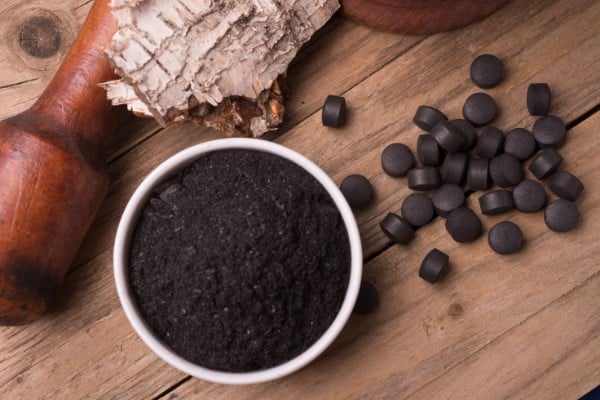
One of the first questions asked by beginners to terrarium building is “Do I Need to Use Charcoal in My Terrarium?“
Although the answer is not necessarily a clear Yes or No, we will look at the reasons presented by those who are for and against using charcoal in terrariums, and try to give you the as much evidence to make an informed choice for your own set up.
So, is it essential to use charcoal in a terrarium? No it is not essential to use charcoal in a terrarium, and many terrariums will survive just fine without having charcoal in them. However in some instances, it is considered beneficial, if not essential, to add a layer of ‘activated’ charcoal to help give new terrariums a better chance of survival.
I will now explain in greater detail the differing arguments I have found when researching the use of charcoal in terrariums.
The following article may contain affiliate links. Any qualifying purchases may provide us with a small commission at no extra cost to yourself. Thank you for the support!
Why Charcoal Is Used In Terrariums
One of the main reasons that charcoal is used in terrarium builds is down to the filtration and absorption qualities that the charcoal provides.
During the early stages of newly established terrariums, the plants contained within are at their most vulnerable. It is during this crucial stage of the development that many builders feel that the charcoal will help remove any harmful toxins that may accumulate within the terrarium environment.
As your terrarium develops its own ecosystem, it will naturally develop waste products such as dying plants or fallen leaves. If these dead elements are not removed, they begin to decay and can produce gasses, toxins and odors that can be unpleasant for the environment. This may lead to further damage to plants such as rot, mould or mildew.
The use of charcoal will help to remove some of these harmful toxins, gasses and smells by absorbing and holding them within the charcoal. This is particularly important if you are looking to build a ‘closed’ terrarium.
Can Any Charcoal Be Used In A Terrarium?
There is conflicting advice throughout terrarium articles that seem to adopt the attitude that ‘any’ kind of charcoal will work, however that is not entirely true.
Common Charcoal
Whilst you may get away with using charcoal that is more common for use in fireplaces or BBQ’s, this type of charcoal has much less absorption qualities than the more recommended ‘active’ charcoal. Also the common charcoal may contain elements that could actually harm your terrarium environment.
Activated Charcoal
During your own research, you have probably seen the term ‘activated charcoal’ or ‘activated carbon’.
‘Activated Charcoal’ is made from heating the more common charcoal to a much higher heat using gas. This high temperature creates larger gaps or ‘pores’ within the charcoal, which allows more space for the absorption process.
Many seasoned terrarium builders are adamant that an ‘activated’ charcoal layer should be used if building a closed or sealed terrarium. However, if access is available within an ‘open’ terrarium, the need becomes less essential.

How Much Charcoal Should Be Used in Terrariums?
Again, this will depend on the type of terrarium build you are looking to do.
Open Terrariums
If you are making an open terrarium, and therefore will have access to remove debris etc, as well as ventilation for toxic gasses, you may not need any charcoal at all. However, in the early stages of a new terrarium, it is not uncommon for builders to mix about 5 – 10% charcoal in with the soil / substrate to give some extra absorption qualities. It certainly doesn’t do any harm!
Sealed / Closed Terrariums
When builders are looking to create a closed / sealed terrarium, it is much more likely that they will include a full layer of ‘activated’ charcoal beneath the soil / substrate, providing a ‘filtration layer’ that will help remove harmful impurities from within the terrarium.
Different Types of Activated Charcoal
‘Activated’ charcoal can be purchased in many forms:
- Powdered
- Chunks
- Pellets
- Tubes
- Granulated
No matter which form is purchased, it all does the same thing. However, depending on the size of the terrarium you are building, may determine the type of carbon you buy.
Generally, if you are building a smaller terrarium, you would want to use a smaller size charcoal such as the powder. This would be easily mixed in with the soil. A much larger build where a whole layer of charcoal is being installed, the pellets or tubes may be the better option.
Terrarium Tip:
Larger pieces of carbon/charcoal can be crushed into smaller pieces or powdered, for use in smaller projects!

Why People Don’t Use Charcoal in Terrariums
As mentioned earlier, not everyone who builds terrariums believes in the need to include charcoal. We will now look at some of the arguments against using it.
Does Charcoal Really Add Any Benefits to a Terrarium?
Many builders have run experiments where they build the same terrarium twice. In one they will add the ‘activated’ charcoal, and in the other they leave it out.
Some of the big names in the world of terrariums have come to the conclusion that after 12 months, there was little difference between the two terrariums, however others still insist that it is an essential part of a build.
Limited Charcoal Absorption
As has been established, the charcoal is added to help absorb unwanted smells, gasses, toxins etc that may build up within the terrarium over time. Now obviously, the charcoal only has ‘so much’ capacity to absorb these elements before it becomes ineffective.
Basically, the charcoal will only remain ‘activated’ for a certain amount of time before it is no longer able to absorb any more. At this point, it is essentially taking up valuable space within the terrarium without adding any further benefit.
Even those who feel the charcoal is a benefit, may decide not to include it if they are limited to space.
Added Costs Involved
Whilst ‘activated’ charcoal or carbon is not overly expensive, it is nevertheless ‘another’ expense.
For some, the money spent on buying the charcoal is much better spent on plants, or other elements within the terrarium that will last a great deal longer than the charcoal.
Alternatives to Using Charcoal in a Terrarium
Some builders that may not agree with the benefits of using charcoal in their terrariums, but do see the benefits of having something within the ecosystem to keep things clean and healthy.
Here are some of those alternatives:
Perlite and Vermiculite
Using perlite or vermiculite mixed within the soil of the terrarium will add further aeration and absorption to the soil. In effect, this will do a similar job of the charcoal and may already be present in the soil you have purchased to use.
Also, if needing to add these, they tend to be a cheaper option than adding the ‘activated’ charcoal.
Insects
There are a variety of insects that can be added to a terrarium that will help to clean up unwanted debris whilst adding natural fertilizer to the ecosystem. Many terrarium owners prefer to add some kind of insect over charcoal as they will continue cleaning the soil during their lifetime as opposed to the charcoal that only works for a limited time.
Springtails and Dwarf Isopods are probably the most popular insects that are added to terrariums.
Moss
Adding a layer of moss to the terrarium will help to absorb odors as well as excess water which may otherwise cause the roots of your plants to rot. A carpet of moss is also more visually pleasing than a layer of charcoal. When using moss, you may find that it needs trimming once in a while

Charcoal or Not – It’s Your Choice!
As you can see from the research. Whether or not to add charcoal to your terrarium really seems to come down to personal choice.
There have certainly been studies by terrarium builders that feel it is not required, whereas others feel a beginner terrarium will benefit from having it added.
Forming my own conclusions I feel that provided you ensure that you have some form of control over the amount of water, debris and decay that is happening in your terrarium, you should be able to get away without needing the charcoal.
However, if you want to set up a new terrarium and basically leave it to do it’s own thing without the addition of insects etc, then perhaps adding the charcoal is the way to go. At least then you know that for a few weeks/months, any nasty elements developing within your environment has a chance of being taken care of with minimal input from you.
When all is said and done, it does seem that your terrarium will not be harmed from the addition of the right type of charcoal, and may in fact have some benefits. If you have room in the terrarium and can afford to use the charcoal, you probably have nothing to lose by putting some in.
